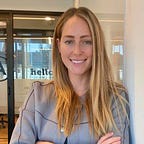The Secret Sauce to Money-Making Landing Page Visuals
They say you only have a few seconds to engage users, which is why a user’s first glance at your landing page is crucial. It’s easy to say what turns users away from a page — slow loading time, intrusive ads, content overload. But is there a secret sauce to making users stick around?
The first things that stand out to users when they land on your page are the layout, colors, and images. We all know that images are worth a thousand words, but at Natural Intelligence, we found out that they can also be worth thousands of dollars.
Our company operates dozens of comparison websites. With an informative chart page that features top brands, thorough reviews, and advice articles, we provide consumers with all the information they need to make the absolute best choice for their needs.
The top area of our landing pages includes a headline, a subheading, and an image, which we call “Header Image”. This section of the page makes the first impression on our users and serves two main purposes:
Assure users they’ve come to the right place
Engage users and prompt them to scroll further
A little over a year ago, we started A/B testing different header images in the purpose of optimizing Bounce Rate, CTR, Conversion Rate, and increasing our overall earnings. Over 200(!) header image tests later, we’re happy to share some of our findings.
Here are the 3 pillars of money-making landing page visuals:
Pillar #1: Tell a Story
Engaging users essentially means evoking their emotions. We’ve found that an excellent way to do this is to tell a compelling story that focuses on the bonds we have with our loved ones. Let’s look at a few examples.
Our mortgage loan comparison website previously displayed an image of a roof. While brainstorming a new test hypothesis, we realized — when you take a mortgage to fund a new home, you’re not just buying a house, you’re buying a whole life.
Your new home will be on a different street, maybe even in a different neighborhood, city or state, and you’ll have new neighbors. This move may be tied with other major events in your life like marriage or starting a family. We chose to communicate this message using an image of a happy family strolling around a beautiful neighborhood, which boosted our site revenue.
Default:
Optimized:
Here’s another example from our DNA kits comparison site. The old image depicted a scientist in a lab. We selected the image based on the belief that people are interested in DNA kits first and foremost due to the scientific innovation they promote.
But there’s more to DNA testing kits than that. People who purchase DNA kits do so in hopes of unveiling information they do not know about their ancestors and genetic background. We wanted to speak to the emotional aspect of DNA testing rather than the scientific curiosity they elicit by using an image of two generations of women. Our hypothesis proved successful and we saw a significantly higher conversion rate.
Default:
Optimized:
Another success story is from our home security systems comparison site. While it makes a lot of sense to display an image of a home security device, we suspected that it didn’t tap into the “why” — people purchase home security systems to protect their home and loved ones. We decided to tell that story with an image of a father protecting his toddlers in a cozy, safe place.
Default:
Optimized:
Pillar #2: Reflect the Product or Target Audience
The following examples illustrate how placing the product at hand in the image improves landing page performance.
The default header image on our Medical Alerts Systems site showed a grandfather sledding with his granddaughter. The idea was to show an older person who’s healthy and in shape enough to engage in physical activity. But we had a sense that we were missing the point — the product was nowhere to be seen, the photo was very seasonal, and focused too much on the young granddaughter who isn’t even old enough to be a caregiver of an older person.
Instead, we tested an image that features a couple wearing an alert device. The affectionate elderly couple better reflected our target audience, and the green background wasn’t as seasonal as the snowy picture. This test was declared a significant win.
Default:
Optimized:
On our French Car Loans comparison website, the original header image showed a young female using her laptop. This woman could be borrowing an auto loan from an online lender, but she could also be doing a million other things like online shopping or writing an essay. Nothing in this image, neither her nor her environment, indicated what she’s currently up to.
We decided to test a more specific image. What is more directly relevant to car loans than a car? This test proved very successful.
Default:
Optimized:
Pillar #3: Show People, Not Objects
Time and time again, we’ve seen that visuals that include humans do better than images that display objects. We’ve found it successful primarily with fintech products.
Here are a few examples:
Default:
Optimized:
Default:
Optimized:
Default:
Optimized:
Research is key
Before you start optimizing, start with research. Every hypothesis mentioned above is based on extensive audience research, a deep understanding of how users navigate our landing page, and what they’re searching for.
Once you’ve done your research, move on to selecting the right image, and make sure it:
- Tells a compelling story that taps into the audience’s emotions
- Clearly and directly reflects the product or target audience at hand
- Shows people of the relevant demographic, and not objects
That’s it. Now you’re ready to optimize away!
Originally published at https://www.naturalint.com on April 26, 2020.
